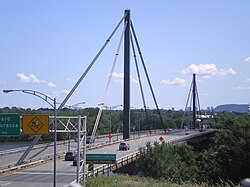Papineau-Leblanc Bridge | |
|---|---|
 The Papineau-Leblanc bridge was one of the first cable-stayed bridges in North America. | |
| Coordinates | 45°34′34″N 73°40′00″W / 45.576°N 73.6666°W |
| Carries | 6 lanes of |
| Crosses | Rivière des Prairies |
| Locale | Laval, Quebec and Montreal, Quebec, Canada |
| Maintained by | Transports Québec |
| Characteristics | |
| Design | Cable-stayed bridge |
| Total length | 420.6 m |
| Width | 27.2 m |
| Longest span | 240 m |
| History | |
| Opened | 1969 |
| Statistics | |
| Daily traffic | 56,000 (2013)[1] |
| Location | |
 | |
The Papineau-Leblanc Bridge was one of the first cable-stayed spans in North America.[citation needed] It is part of Quebec Autoroute 19 and is one of the connections between Laval and Montreal, Quebec, Canada, spanning Rivière des Prairies. It was fabricated from weathering steel and has an orthotropic deck. The freeway ends abruptly at the southern end of the bridge at the intersection of Henri Bourassa Boulevard, where Autoroute 19 follows Avenue Papineau down to Quebec Autoroute 40.
The Leblanc portion of the name comes from the name of a street in Laval that was expropriated to build the autoroute. That street was named after Alpha Leblanc, a local landowner. Portions of that street remain on both sides of the autoroute.
In 2000, a proposition to rename the bridge after the late Pietro Rizzuto was initially approved, then rejected by the Commission de Toponymie du Québec, which ruled that the name Papineau-Leblanc was already entrenched in local culture and non-controversial. Most locals simply refer to this bridge as Papineau.[2]
- ^ Bisson, Bruno. "Pont de l'A-25: ça roule pour le MTQ". La Presse. Retrieved June 25, 2014.
- ^ Debates - Issue 24 - February 8, 2000